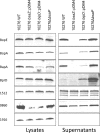Quantitative proteomic analysis of Burkholderia pseudomallei Bsa type III secretion system effectors using hypersecreting mutants
- PMID: 25635268
- PMCID: PMC4390269
- DOI: 10.1074/mcp.M114.044875
Quantitative proteomic analysis of Burkholderia pseudomallei Bsa type III secretion system effectors using hypersecreting mutants
Abstract
Burkholderia pseudomallei is an intracellular pathogen and the causative agent of melioidosis, a severe disease of humans and animals. One of the virulence factors critical for early stages of infection is the Burkholderia secretion apparatus (Bsa) Type 3 Secretion System (T3SS), a molecular syringe that injects bacterial proteins, called effectors, into eukaryotic cells where they subvert cellular functions to the benefit of the bacteria. Although the Bsa T3SS itself is known to be important for invasion, intracellular replication, and virulence, only a few genuine effector proteins have been identified and the complete repertoire of proteins secreted by the system has not yet been fully characterized. We constructed a mutant lacking bsaP, a homolog of the T3SS "gatekeeper" family of proteins that exert control over the timing and magnitude of effector protein secretion. Mutants lacking BsaP, or the T3SS translocon protein BipD, were observed to hypersecrete the known Bsa effector protein BopE, providing evidence of their role in post-translational control of the Bsa T3SS and representing key reagents for the identification of its secreted substrates. Isobaric Tags for Relative and Absolute Quantification (iTRAQ), a gel-free quantitative proteomics technique, was used to compare the secreted protein profiles of the Bsa T3SS hypersecreting mutants of B. pseudomallei with the isogenic parent strain and a bsaZ mutant incapable of effector protein secretion. Our study provides one of the most comprehensive core secretomes of B. pseudomallei described to date and identified 26 putative Bsa-dependent secreted proteins that may be considered candidate effectors. Two of these proteins, BprD and BapA, were validated as novel effector proteins secreted by the Bsa T3SS of B. pseudomallei.
© 2015 by The American Society for Biochemistry and Molecular Biology, Inc.
Figures



Similar articles
-
The Burkholderia pseudomallei Proteins BapA and BapC Are Secreted TTSS3 Effectors and BapB Levels Modulate Expression of BopE.PLoS One. 2015 Dec 1;10(12):e0143916. doi: 10.1371/journal.pone.0143916. eCollection 2015. PLoS One. 2015. PMID: 26624293 Free PMC article.
-
Burkholderia pseudomallei BopE suppresses the Rab32-dependent defense pathway to promote its intracellular replication and virulence.mSphere. 2024 Nov 21;9(11):e0045324. doi: 10.1128/msphere.00453-24. Epub 2024 Oct 21. mSphere. 2024. PMID: 39431830 Free PMC article.
-
Type III Secretion in the Melioidosis Pathogen Burkholderia pseudomallei.Front Cell Infect Microbiol. 2017 Jun 15;7:255. doi: 10.3389/fcimb.2017.00255. eCollection 2017. Front Cell Infect Microbiol. 2017. PMID: 28664152 Free PMC article. Review.
-
BipC, a Predicted Burkholderia pseudomallei Type 3 Secretion System Translocator Protein with Actin Binding Activity.Front Cell Infect Microbiol. 2017 Jul 19;7:333. doi: 10.3389/fcimb.2017.00333. eCollection 2017. Front Cell Infect Microbiol. 2017. PMID: 28770177 Free PMC article.
-
Unraveling type III secretion systems in the highly versatile Burkholderia pseudomallei.Trends Microbiol. 2010 Dec;18(12):561-8. doi: 10.1016/j.tim.2010.09.002. Epub 2010 Oct 15. Trends Microbiol. 2010. PMID: 20951592 Review.
Cited by
-
Rapid and Sensitive Multiplex Detection of Burkholderia pseudomallei-Specific Antibodies in Melioidosis Patients Based on a Protein Microarray Approach.PLoS Negl Trop Dis. 2016 Jul 18;10(7):e0004847. doi: 10.1371/journal.pntd.0004847. eCollection 2016 Jul. PLoS Negl Trop Dis. 2016. PMID: 27427979 Free PMC article.
-
Deciphering the human antibody response against Burkholderia pseudomallei during melioidosis using a comprehensive immunoproteome approach.Front Immunol. 2023 Dec 11;14:1294113. doi: 10.3389/fimmu.2023.1294113. eCollection 2023. Front Immunol. 2023. PMID: 38146371 Free PMC article.
-
Hijacking of the Host's Immune Surveillance Radars by Burkholderia pseudomallei.Front Immunol. 2021 Aug 11;12:718719. doi: 10.3389/fimmu.2021.718719. eCollection 2021. Front Immunol. 2021. PMID: 34456925 Free PMC article. Review.
-
The Burkholderia pseudomallei Proteins BapA and BapC Are Secreted TTSS3 Effectors and BapB Levels Modulate Expression of BopE.PLoS One. 2015 Dec 1;10(12):e0143916. doi: 10.1371/journal.pone.0143916. eCollection 2015. PLoS One. 2015. PMID: 26624293 Free PMC article.
-
Identification of novel substrates of Shigella T3SA through analysis of its virulence plasmid-encoded secretome.PLoS One. 2017 Oct 26;12(10):e0186920. doi: 10.1371/journal.pone.0186920. eCollection 2017. PLoS One. 2017. PMID: 29073283 Free PMC article.
References
-
- Strauss J., Groves M., Mariappan M., Ellison D. W. (1969) Melioidosis in Malaysia II. Distribution of Pseudomonas pseudomallei in soil and surface water. Am. J. Trop. Med. Hyg. 18, 698–702 - PubMed
-
- Wiersinga W. J., Currie B. J., Peacock S. J. (2012) Melioidosis. N. Engl. J. Med. 367, 1035–1044 - PubMed
-
- Wiersinga W. J., van der Poll T., White N. J., Day N. P., Peacock S. J. (2006) Melioidosis: insights into the pathogenicity of Burkholderia pseudomallei. Nat. Rev. Microbiol. 4, 272–282 - PubMed
Publication types
MeSH terms
Substances
Grants and funding
LinkOut - more resources
Full Text Sources

